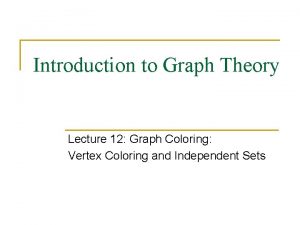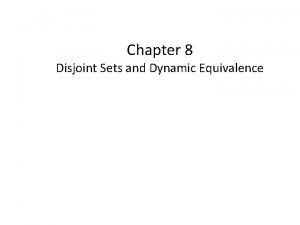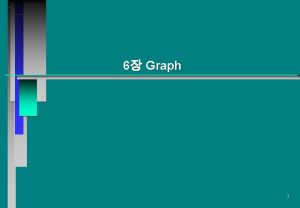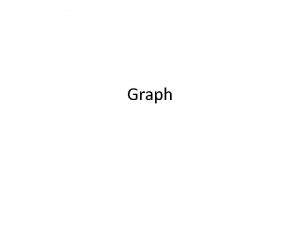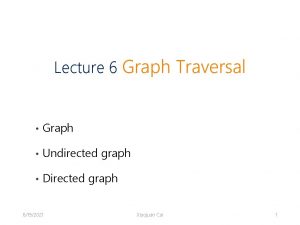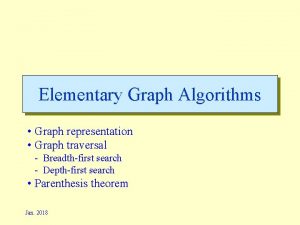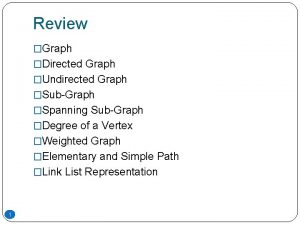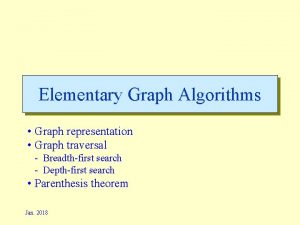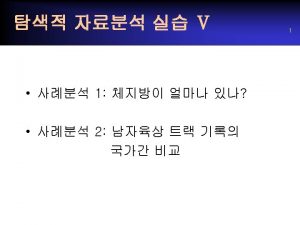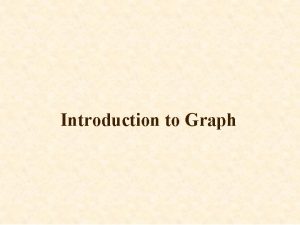Graph A graph G is a set VG















- Slides: 15

Graph A graph G is a set V(G) of vertices (nodes) and a set E(G) of edges which are pairs of vertices. a b c d e f g h i j k l V = { a, b, c, d, e, f, g, h, i, j, k, l } E = { (a, b), (a, e), (b, f), (c, j), (c, g), (c, h), (d, h), (e, j), (g, k), (g, l), (g, h), (i, j) }

A Directed Graph In a directed graph (digraph), edges are ordered pairs. TW 45 NW 35 ORD UA 877 12 UA AA 49 LAX JFK DL 247 AA 903 AA 1387 DL 335 0 SFO BOS MIA AA 523 DFW AA 411 From Goodrich and Tamassia, 1998

Applications of Graphs describe relationships The Internet Streets / Highways (Roadmaps) Molecules Social Networks Geometric Surfaces (CAD) Circuits Parts in an Assembly …

More General Graphs A multipgraph allows multiple edges between two vertices. a c b d f A pseudograph is a multigraph that allows self-loops (edges from a vertex to itself). 1 2 3 4 5 6

Edges & Degrees w e 2 u degree(u) = 2 deg(w) = 1 u and v are adjacent e 1 endpoint v incident on u and v in-degree(b) = 3 out-degree(b) = 4 source b c a destination e d

Handshaking Theorem Let G = (V, E) be an undirected simple graph. ∑ deg(v) = 2 | E | ≤ | V | · (| V | – 1) / 2 v V K 4 has ( 4 2) = 6 edges If G is directed: ∑ v V indeg(v) = ∑ outdeg(v) = | E | v V | E | ≤ | V | · (| V | – 1)

Path A path of length k is a sequence v 0 , v 1 , …, v k of vertices such that (vi , vi+1 ) for i = 0, 1, …, k – 1 is an edge of G. b, c, d not a path Simple path: a, e, k, p, l, q m, h, d, c, g (no repeated vertices) a b c d e f g h j k l m n o p q Non-simple path: a, b, e, f, g, b, g, l

Cycle A cycle is a path that starts and ends at the same vertex. A simple cycle has no repeated vertices. k, j, n, k, p, o, k is not simple. a b c d e f g h j k l m n o p q

Subgraph A subgraph H of G is a graph; its edges and vertices are subsets of those of G. a b c d e f g h j k l m n o p q V(H) = {b, d, e, f, g, h, l, p, q} E(H) = {(b, e), (b, g), (e, f), (d, h), (l, p), (l, q)}

Connectivity G is connected if there is a path between every pair of vertices. a d b c f e If G is not connected, the maximal connected subgraphs are the connected components of G. C 3 C 2 a d e f g C 1 b c

Strong & Weak Connectivity A directed graph is strongly connected if every two vertices are reachable from each other. b a e f d c It is weakly connected if the underlying undirected graph is connected. c f b e d a

Property of Connectivity Let G = (V, E) be an undirected graph. If G is connected, then | E | ≥ | V | – 1. If G is a tree, then | E | = | V | – 1. If G is a forest, then | E | ≤ | V | – 1.

Adjacency Lists Adj 2 1 1 3 5 4 2 3 4 5 2 1 1 3 3 2 3 1 5 3 5 4 If G is directed, the total length of all the adjacency lists is | E |. If G is undirected, the total length is 2 | E |. Space requirement: (|V| + |E|). Preferable representation.

Adjacency Matrix A = (a ij ) 2 1 3 5 4 a ij = 1 2 3 4 5 1 2 3 0 1 1 1 0 0 0 1 1 if (i, j) E(G) 0 otherwise 4 5 0 1 0 0 1 1 0 Space: (|V|2 ). Preferred when the graph is small or dense.

Operation Time Operation Adjacency List Adjacency Matrix Scan incident edges (deg(v)) (|V|) Scan outgoing edges (outdeg(v)) (|V|) Scan incoming edges (indeg(v)) (|V|) Test adjacency of u and v Space (min(deg(u), deg(v)) (|V|+|E|) O(1) (|V| 2 ) Lecture notes modified over Dr. Fernandez-Baca’s
 Training set validation set test set
Training set validation set test set Total set awareness set consideration set
Total set awareness set consideration set Crisp set vs fuzzy set
Crisp set vs fuzzy set Bounded set vs centered set
Bounded set vs centered set What is the overlap of data set 1 and data set 2?
What is the overlap of data set 1 and data set 2? Fuzzy logic
Fuzzy logic Correspondence function examples
Correspondence function examples Crisp set vs fuzzy set
Crisp set vs fuzzy set What is an independent set in a graph
What is an independent set in a graph Define graph coloring
Define graph coloring Graph set up
Graph set up Resource allocation graph and wait for graph
Resource allocation graph and wait for graph Bridge graph
Bridge graph Ayat mudah bahasa arab
Ayat mudah bahasa arab Teknik cetak grafis
Teknik cetak grafis Disjoint set adt
Disjoint set adt









